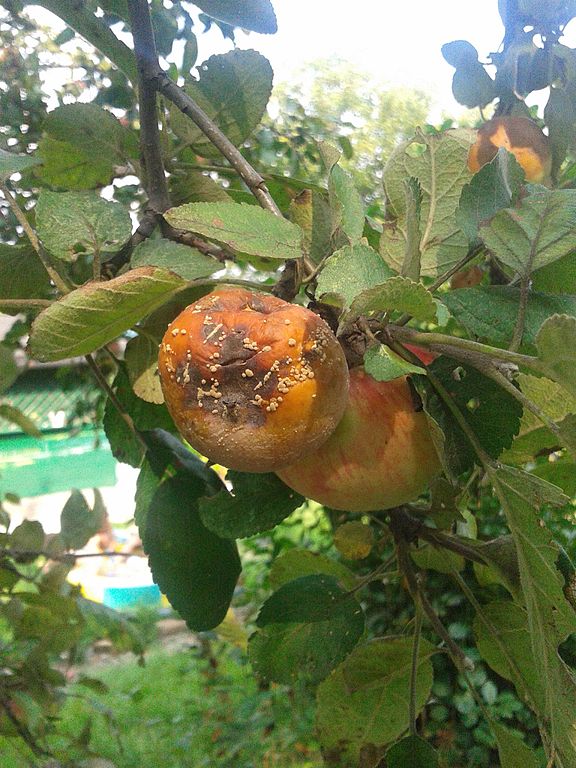Introduction
Brown rot, also called European brown rot, is a fungal disease that infects the blossoms and fruit of stone fruit trees, almond, and occasionally pome fruit trees. It is the most significant disease of stone fruit trees, and occurs globally. Brown rot was first described in 1796. It is caused by three closely related fungi: Monilinia fruiticola, M. laxa, and M. fructigena. Brown rot infections spread quickly, blighting vulnerable flowers, and causing a soft rot of fruit. Infected trees will often experience a drastic or total loss in fruit yield.
Distribution & Habitat
Of the three fungal pathogens that cause brown rot, Monilinia fruitcola is the most common. M. fruticola can be found across Australia, Japan, New Zealand, North America, and South America. M. laxa occurs in all of the same locations. It is the most frequently observed brown rot pathogen in Chile, Europe, and South Africa. M. fructigena infects stone and pome fruits in Asia and Europe.
Hosts
Brown rot primarily attacks stone fruits (cherries, nectarines, peaches, and plums). It may also infect almonds, and pome fruit trees (apples, nashi, pears, and quince), albeit with less frequency.
Disease Cycle
The brown rot pathogens overwinter on infected plant material. In spring, when temperatures have risen and conditions are sufficiently moist, small fruiting bodies arise on the surface of the diseased plant parts. The fruiting bodies contain asexual spores called conidia. The presence of conidia in the fruiting bodies distinguishes brown rot from other fungal diseases of stone fruits. During rainstorms, the fruiting bodies rupture and expel spores, which are disseminated to vulnerable trees by air currents, splashes of rain, or insect vectors. The spores infect young blossoms and shoots. They infect the anthers and pistils of susceptible tree blossoms first. The spores then invade the rest of the flower, eventually penetrating into the twig the blossom is attached to. If conditions are favorable, the spores can germinate in the plant within 3 to 5 hours. Once the brown rot pathogen has become established, it spreads throughout the crown, inducing the formation of cankers that can girdle and kill young, flower-bearing stems. When infections are severe, all of a tree’s blossoms may be destroyed, resulting in a total loss of fruit for the year.
At times, small, mushroom-like structures called apothecia may develop on mummified fruit that has been cast. The apothecia produce ascospores that are released when conditions are wet. The ascospores are carried by splashes of rain, air currents, or insects to susceptible tree blossoms, which they readily infect. Fruit infections are most prevalent in the weeks leading up to harvest. Green, immature fruits are seldom infected unless they have been wounded. As fruits ripen, their sugar content increases, rendering them more prone to infection. Brown rot infections can occur at any point during the growing season.
Symptoms of Infection
Brown rot causes infected blossoms and twigs to become blighted. Infected fruits undergo a soft decay, forming circular, brown spots, or lesions, that rapidly spread over the surface. Infected fruit will become desiccated, and often cling to the tree. Diseased blossoms will wilt and turn brown. Dead flowers will generally remain attached to infected trees into fall. Ash grey to brown masses of spores can be observed erupting from the fruiting bodies in spring. A gummy substance may exude from the cankers, and streak down onto the wood of infected trees.
Management
- When planting, select varieties that exhibit an increased resistance to brown rot infection.
- Promptly remove and dispose of any infected plant material. Avoid composting diseased plant debris.
- Rake up and destroy any fruit or plant debris that has been shed from trees.
- Maintain tree vigor through sound cultural practices. Ensure that trees are sufficiently watered, especially during periods of extended drought.
- Apply mulch around the base of vulnerable plants to improve the soil quality, and retain soil moisture.
- Prune trees to improve air circulation throughout the crown, and to promote a rapid drying of wet blossoms and foliage.
- Numerous fungicides and sulfur powders can be applied to infected trees to combat the disease. Initial applications should be performed just as budburst begins. Subsequent applications can be performed at weekly intervals until the growing season has concluded.
Photo courtesy of CC-by-3.0


